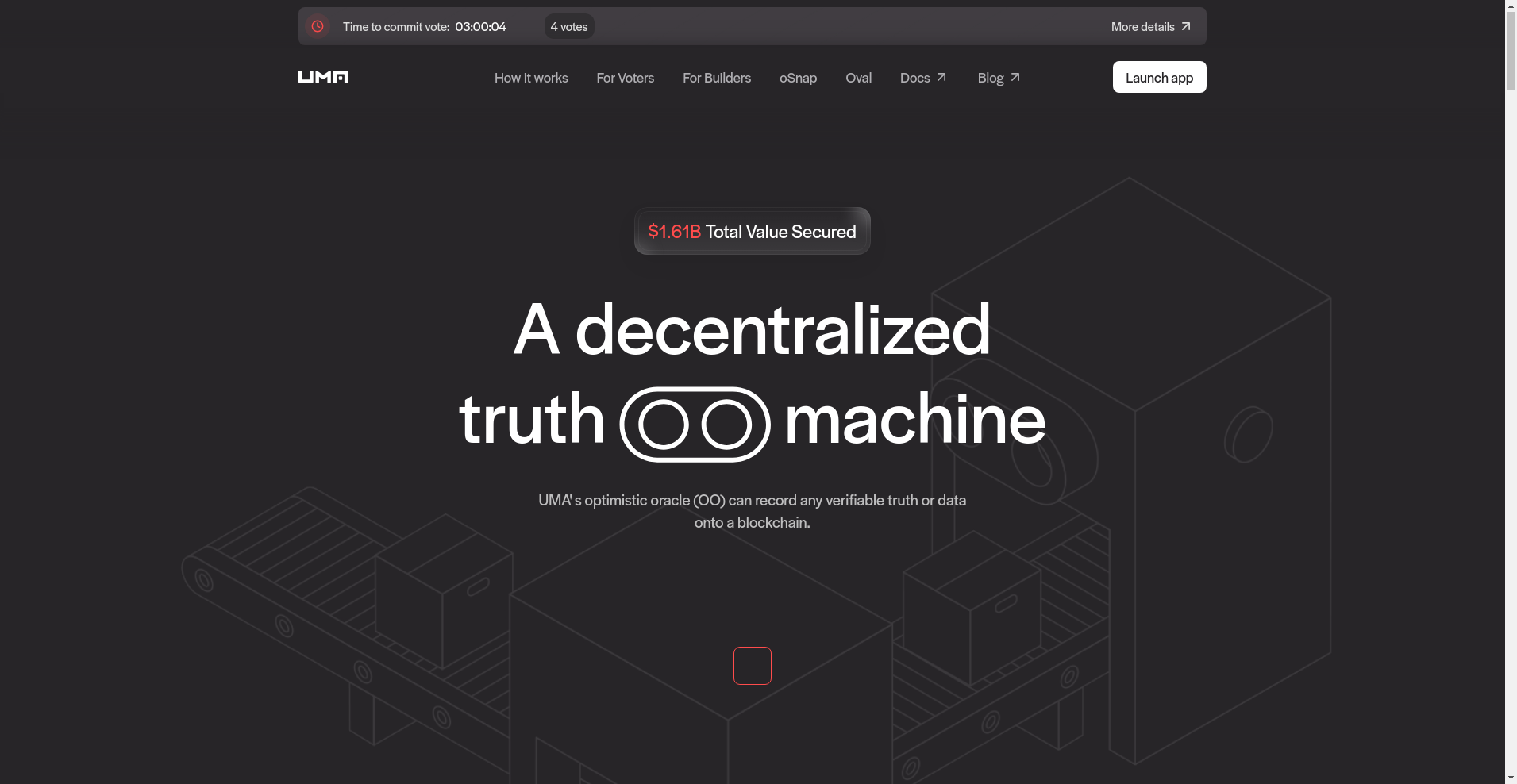UMA ($UMA) Review: A Data-Driven Look at Its Legitimacy, Risks & Long-Term Potential

What Is UMA: An Introduction
UMA, or Universal Market Access, positions itself as a decentralized platform enabling the creation and management of synthetic assets and smart contracts. Its defining feature is the Optimistic Oracle (OO), a protocol designed to provide verifiable truth data that can be integrated into various DeFi applications. By embedding this oracle, UMA aims to facilitate trustless agreements, dispute resolution, and cross-chain interoperability. Innovations in optimistic oracle technology are crucial for this advancement.
This review offers an impartial analysis of UMA’s core technology, security posture, tokenomics, and ecosystem activity, providing readers with a clear understanding of its strengths and potential vulnerabilities. As with any DeFi project, transparency and security are paramount — this is where scrutiny becomes essential.
The Team and Vision Behind UMA
UMA’s development history is publicly attributed to the Risk Labs Foundation. The team includes notable figures with backgrounds in finance, cryptography, and blockchain development, although their identities are not always extensively public. This blend of transparency and anonymity is common in DeFi but warrants careful evaluation when assessing credibility. The work of the Risk Labs Foundation is central to UMA's development.
Roadmap milestones suggest a focus on enhancing core oracle capabilities, expanding ecosystem partnerships, and building user-friendly interfaces. Key targets include increased adoption of the Optimistic Oracle, integration with major DeFi protocols, and expanded developer tools. The timeline shows steady progress but remains subject to market-driven delays or technical hurdles.
- Q1 2023: Launch of v2 of the Optimistic Oracle with performance improvements
- Q2 2023: Integration with prominent DeFi platforms like Aave and Compound
- Q3 2023: Deployment of products like oSnap for DAO governance
Overall, UMA’s team appears to possess the technical competence to deliver on their roadmap, but the decentralized and open nature of blockchain projects always leaves some uncertainty about long-term execution success.
Assessing the Security and Integrity of UMA
This section is based on the security audit findings from Cer.live, the only major publicly available report. It is important to recognize that although UMA has undergone an audit, the platform’s full security posture may contain unaddressed vulnerabilities due to the complex nature of its smart contracts.
Audit analyses provide insights into potential attack surfaces, logic flaws, or administrative risks. Here, we explore the key takeaways from the Cer.live report:
- Overall audit coverage: 80%. While comprehensive, certain modules may not have been fully scrutinized, leaving residual risks.
- Vulnerabilities detected: The report mentions some bugs, but none are classified as critical, though minor issues could be exploited under specific conditions.
- Centralization concerns: Critical governance functions or upgrades are perhaps controlled by limited key holders, posing potential points of failure.
- Audit scope limitations: Platform-specific aspects, such as upgrades or cross-chain bridges, remain unaudited or partially audited, which can be exploited if not closely monitored.
While the security audit suggests a generally sound framework, the open-ended nature of DeFi exploits means users should remain cautious. The absence of a fully platform-audited codebase implies that unseen tripwires or logic bombs could exist, and thus, the risk persists.
A Breakdown of UMA Tokenomics
The economic design of UMA hinges on its native token, UMA ($UMA), with a total supply of approximately 124.45 million tokens. Understanding its distribution, utility, and inflationary mechanics is vital for assessing its sustainability and investment potential. The tokenomics of projects often influence their participation in mechanisms like yield farming.
- Total Supply: ~124.45 million UMA tokens
- Circulating Supply: Around 86.55 million UMA (as per latest data)
- Market Cap: Approximately $100.5 million, reflecting a modest valuation with significant growth potential
- Token Distribution: Details suggest a substantial allocation for team, early investors, and community incentives, often with vesting periods that mitigate immediate inflation risks.
- Utility: UMA tokens are primarily used for governance, staking, and disputes in the oracle system, aligning incentives between network security and utility.
- Inflation / Deflation: The supply structure indicates minimal inflationary pressure, given the capped total supply and vesting schedules for insiders.
The tokenomics model appears balanced, favoring long-term alignment of incentives. However, the reliance on community participation for governance and disputes can be both a strength and a risk if the ecosystem fails to attract active voters or if voting power concentrates.
Assessing UMA's Development and Ecosystem Activity
From available data, UMA maintains a steady cadence of development, with ongoing bug bounty programs and active community engagement. The presence of projects like ACROSS, POLYMARKET, and SNAPSHOT utilizing UMA’s Optimistic Oracle signifies real-world adoption beyond just theoretical templates. Such adoption contributes to the overall ecosystem's health and can be analyzed through various transaction monitoring tools.
Recent updates highlight incremental improvements and increased integrations with other DeFi protocols, indicating an ecosystem with tangible momentum. Nevertheless, some marketing claims tend to outpace actual deployment, a common challenge in the DeFi sphere. The true measure of activity lies in the sustained development, code commits, and usage statistics, which appear promising but require ongoing monitoring.
The Fine Print: Analyzing UMA's Terms
UMA’s terms and conditions, accessible via their official documentation, do not appear to contain overly complex or risky clauses. The project emphasizes transparency and open-source principles, with regular updates and community involvement. No immediately apparent clauses raise red flags concerning legal risks or operational limitations.
However, potential risks include the dependency on Ethereum’s security, the possibility of governance attacks if voting power becomes centralized, or successful dispute resolution mechanisms being exploited if not robustly designed.
Final Analysis: The Investment Case for UMA
UMA presents itself as a technically innovative project with a clear mission: to make markets more accessible and trustless through decentralized oracles. Its core technology, the Optimistic Oracle, offers versatility that could underpin a broad array of DeFi applications.
From a legitimacy perspective, UMA’s strong foundation via reputable audits and active development suggests operational credibility. Still, the risks inherent in smart contract security, governance centralization, and market volatility necessitate cautious positioning.
Investors should consider UMA’s modest valuation relative to its growing ecosystem and the potential for widespread adoption. However, the platform’s reliance on user participation for dispute resolution and the partial security audits leave open avenues for exploit or failure, especially if critical bugs are discovered post-audit.
Pros / Strengths
- Innovative use of optimistic oracle technology for trustless data verification
- Active development progress and real-world integrations
- Balanced tokenomics with capped supply and vesting schedules
- Large total value secured ($1.61B), indicating confidence from users and integrations
- Existing ecosystem of projects leveraging UMA’s oracle solutions
Cons / Risks
- Limited full platform audit; potential undiscovered vulnerabilities
- Dependence on community governance, which may suffer from centralization or voter apathy
- Possible exploits in complex smart contract interactions or upgrade pathways
- Market volatility and liquidity risks inherent in DeFi tokens
- Uncertain long-term compliance and regulatory landscape surrounding oracles and DeFi protocols
In conclusion, UMA shows promise as an infrastructural piece of the DeFi puzzle but warrants careful due diligence. Its legitimacy is supported by technical innovation and active ecosystem efforts, yet the security and governance risks require ongoing vigilance. As with any investment in the DeFi space, cautious positioning and continuous monitoring are advised.

Michael Brown
Head of Protocol Security & Audits
Systems engineer applying mission-critical principles to DeFi. I stress-test smart contracts and economic models to find the breaking points before they find your wallet.
Similar Projects
-
EXPERT_MONEY
EXPERT_MONEY ($EXPERT) Review: A Deep Dive into Its Tech & Risks
-
Biswap
Biswap Review: Scam Check & Legitimacy Analysis of a Failed Crypto Project
-
Geeked
In-Depth Geeked Review: Is This MemeCoin Scam or Legit? Crypto Scam Checker & Project Review
-
RIZZ
Comprehensive RIZZ Review: Is this Crypto Project a Scam? Crypto Scam Checker & Review
-
Elephant Money
Elephant Money ($ELEPHANT) Review: A Data-Driven Assessment of Its Legitimacy and Risks